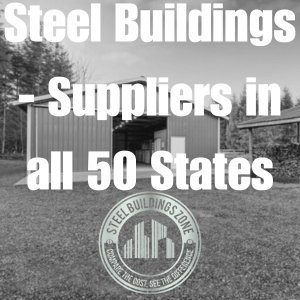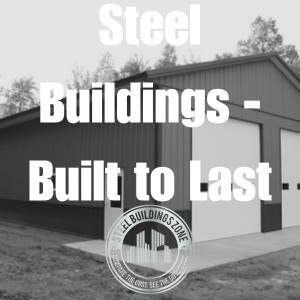
Maximizing Energy Efficiency in Steel Building Designs
In the realm of modern construction, steel buildings have emerged as a beacon of innovation, combining durability with aesthetic flexibility. Among their many advantages, energy efficiency stands out as a key benefit, especially in an era where sustainable practices are not just preferred but essential. This comprehensive guide delves into how maximizing energy efficiency in steel building designs is not only beneficial for the environment but also cost-effective in the long term.
Understanding Energy Efficiency in Steel Buildings
Energy efficiency in buildings refers to the use of less energy to perform the same function. In steel buildings, this efficiency is achieved through various design elements, construction techniques, and material choices. Efficient buildings reduce unnecessary energy consumption, greenhouse gas emissions, and demand for non-renewable resources while providing the same level of comfort, illumination, heating, or cooling.
The Importance of Energy Efficiency
- Environmental Impact: Reducing energy consumption lessens the ecological footprint of a building.
- Cost Savings: Energy-efficient buildings lower utility bills and operational costs.
- Regulatory Compliance: Many regions now have strict building codes focused on energy efficiency.
- Comfort: Energy-efficient designs contribute to a more comfortable and healthier indoor environment.

Key Strategies for Energy-Efficient Steel Buildings
1. Insulation
- High-Performance Insulation: The right insulation is crucial in minimizing heat loss during colder months and heat gain during warmer months. Materials like fiberglass, rigid foam, and reflective insulation are effective in steel buildings.
2. Energy-Efficient Windows and Doors
- Low-Emissivity Windows: Windows coated with low-emissivity (low-E) materials reduce infrared and ultraviolet light without minimizing light. They help keep heat in during the winter and out during the summer.
- Proper Sealing: Ensuring that windows and doors are properly sealed prevents air leaks, further enhancing energy efficiency.
3. Roofing
- Cool Roofs: Using materials that reflect more sunlight and absorb less heat can significantly reduce cooling needs. Cool metal roofs are an excellent choice for steel buildings.
- Proper Ventilation: A well-designed roof ventilation system reduces heat buildup and prevents moisture accumulation.
4. Energy-Efficient HVAC Systems
- Proper Sizing and Installation: HVAC systems should be correctly sized for the steel building. Oversized or undersized systems can lead to inefficiency and increased energy costs.
- Regular Maintenance: Keeping HVAC systems well-maintained ensures they operate efficiently.
5. Use of Renewable Energy Sources
- Solar Panels: Integrating solar panels into the design of steel buildings can drastically reduce reliance on traditional energy sources.
- Wind Energy: In windy locales, small wind turbines can supplement energy needs.
6. Smart Lighting Solutions
- LED Lighting: LED lights are more energy-efficient and have a longer lifespan compared to traditional lighting.
- Natural Light Utilization: Designing buildings to maximize natural light can significantly reduce the need for artificial lighting during the day.
7. Building Orientation and Layout
- Strategic Orientation: The orientation of the building can influence heating and cooling needs. For example, in the Northern Hemisphere, maximizing southern exposure can benefit from natural solar heat.
8. Water Conservation Techniques
- Efficient Water Fixtures: Low-flow toilets, faucets, and showerheads reduce water usage, thereby conserving energy.
9. Landscaping
- Strategic Landscaping: Trees and shrubs can provide shade and wind protection, contributing to the building’s energy efficiency.

The Role of Building Information Modeling (BIM)
Building Information Modeling (BIM) is revolutionizing the way we approach the design and construction of steel buildings, especially in the context of energy efficiency. BIM goes beyond traditional blueprints and 2D drawings, offering a dynamic 3D modeling process that brings a new level of insight and precision to the construction industry. Let’s explore how BIM plays a crucial role in enhancing the energy efficiency of steel buildings.
What is Building Information Modeling (BIM)?
BIM is a digital representation of the physical and functional characteristics of a building. It’s a collaborative process that allows architects, engineers, and builders to plan, design, construct, and manage buildings with high precision using 3D models. BIM integrates detailed information about every component of a building, making it an invaluable tool in the design and construction process.
Enhancing Energy Efficiency with BIM
1. Accurate Energy Performance Simulation
- Early Stage Analysis: BIM allows for the simulation of a building’s energy performance right from the early design stages. It can model how different design choices impact energy efficiency, including insulation types, window placements, and building orientation.
- Predictive Analysis: By simulating various scenarios, BIM helps in predicting the energy performance of a building, guiding decisions that enhance efficiency.
2. Integrating Renewable Energy Solutions
- Solar Panel Placement: BIM can be used to determine the optimal placement for solar panels on a building, considering factors like roof angle, orientation, and potential shading from surrounding structures.
- Wind Flow Analysis: For integrating wind energy solutions, BIM can analyze wind flow patterns around the building, aiding in the optimal placement and sizing of wind turbines.
3. Optimizing Heating, Ventilation, and Air Conditioning (HVAC) Systems
- System Design: BIM aids in designing HVAC systems that are perfectly sized and tailored for the building, ensuring that they operate at peak efficiency.
- Ductwork and Piping: Through BIM, the layout of ductwork and piping can be optimized for efficiency, reducing energy losses.
4. Lighting and Electrical Systems
- Maximizing Natural Light: BIM helps in designing spaces to maximize the use of natural light, thereby reducing the reliance on artificial lighting.
- Efficient Electrical Layouts: It also aids in creating efficient electrical layouts that minimize energy waste.
5. Material Optimization
- Sustainable Materials Selection: BIM can assist in selecting materials that are not only durable but also contribute to the building’s overall energy efficiency.
- Waste Reduction: By optimizing material requirements and cutting down on waste, BIM contributes to more sustainable building practices.
6. Collaboration and Coordination
- Interdisciplinary Collaboration: BIM facilitates better collaboration among architects, engineers, and contractors. This collaboration is essential for ensuring that energy-efficient strategies are integrated throughout the design and construction process.
- Conflict Detection: BIM helps in detecting potential conflicts in the design phase, preventing costly modifications during construction.

The Future of BIM in Steel Building Design
The future of BIM is geared towards even more integrated, intelligent, and automated processes. Advancements in BIM technology will likely include more sophisticated energy modeling capabilities, integration with artificial intelligence for predictive analytics, and enhanced virtual reality experiences for better visualization and decision-making.
In essence, BIM is not just a tool for building design; it’s a comprehensive process that plays a pivotal role in realizing energy-efficient steel buildings. By leveraging BIM, designers and builders can make informed decisions that significantly reduce energy consumption and promote sustainability. As the demand for energy-efficient buildings grows, BIM will undoubtedly become an even more integral part of the design and construction landscape, pushing the boundaries of what is possible in sustainable building design.
The Future of Energy Efficiency in Steel Buildings
As technology advances, the potential for energy-efficient steel buildings grows. Innovations in materials, construction techniques, and smart technology integration are continually enhancing the energy efficiency of steel buildings. The future promises buildings that are not only energy self-sufficient but also active contributors to a sustainable environment.
Maximizing energy efficiency in steel building designs represents a commitment to sustainability, cost-effectiveness, and innovation. By integrating efficient materials, smart design, and renewable energy sources, steel buildings can significantly reduce environmental impact while providing long-term economic benefits. As we move forward, the focus on energy-efficient steel buildings will undoubtedly grow, paving the way for a more sustainable and responsible approach to construction and design.

Comparing the Energy Efficiency of Steel Buildings to Traditional Construction
In the quest for more sustainable and energy-efficient building solutions, the comparison between steel buildings and traditional construction methods becomes highly relevant. Both have their distinct characteristics and advantages, but when it comes to energy efficiency, several factors set them apart. Let’s explore how the energy efficiency of steel buildings compares to traditional construction methods.
Material Efficiency and Sustainability
- Steel’s Recyclability: Steel stands out for its recyclability. It can be recycled indefinitely without losing quality, making it a more sustainable choice. In contrast, many traditional building materials have lower recyclability rates.
- Resource Efficiency: Steel buildings often require fewer raw materials than traditional buildings, as steel has a higher strength-to-weight ratio. Traditional construction materials like wood or concrete typically require more volume to achieve the same strength and durability.
Thermal Performance and Insulation
- Insulation Advantages: Modern steel buildings are designed with advanced insulation materials that fit snugly between steel panels, reducing thermal bridging and heat loss. Traditional buildings, especially older ones, may have less effective insulation and more thermal bridges, leading to higher energy consumption for heating and cooling.
- Air Tightness: Steel buildings can be constructed to be very airtight, which is crucial for maintaining energy efficiency. Traditional buildings, depending on the construction method and materials, can sometimes struggle with air leaks, which can lead to higher energy use.
Speed and Efficiency of Construction
- Rapid Construction: Steel buildings are often faster to erect compared to traditional construction. This efficiency reduces the energy and resources expended during the construction phase. Traditional construction methods typically take longer, which can lead to higher energy consumption over the course of the building process.

Design Flexibility and Adaptability
- Flexible Design for Energy Efficiency: Steel’s strength and versatility allow for designs that can maximize natural light and ventilation, contributing to reduced energy use. In contrast, traditional construction methods might be more limited in terms of large, open spaces that allow for such energy-efficient designs.
- Adaptability and Retrofitting: Steel buildings can be more easily modified or expanded, which helps in retrofitting older structures with new, energy-efficient technologies. Traditional buildings might require more extensive work for similar upgrades.
Lifecycle Energy Consumption
- Longevity and Durability: Steel buildings are known for their durability and longevity. The longer a building lasts with minimal need for repairs or replacements, the more energy-efficient it becomes over its lifecycle. Traditional buildings, depending on the materials and construction quality, may require more frequent maintenance, impacting their overall energy efficiency.
Reflectivity and Heat Island Effect
- Heat Reflection: Steel roofing, especially when treated with reflective coatings, can significantly reduce heat absorption, a feature particularly beneficial in hot climates. This reflectivity can reduce the urban heat island effect and lower cooling costs. Traditional roofing materials may absorb more heat, increasing the need for air conditioning.
When comparing steel buildings to traditional construction methods, several factors contribute to the superior energy efficiency of steel buildings. From material sustainability and thermal performance to construction efficiency and design flexibility, steel buildings offer a range of benefits that can lead to significant energy savings. While traditional construction methods have their own merits, the advanced technology and innovations in steel building design and construction make them a compelling choice for projects prioritizing energy efficiency and sustainability.
For businesses and individuals looking to invest in steel buildings, understanding and implementing these energy-efficient strategies can lead to significant benefits. Whether it’s through incorporating advanced insulation materials, optimizing the building layout, or utilizing smart technologies, every step towards energy efficiency is a step towards a more sustainable and economically sound future.

Leave a Reply